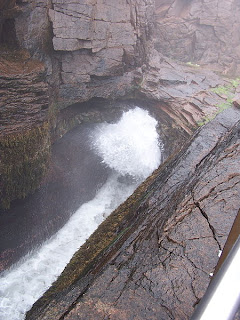I had the opportunity to visit the USA, thanks to my older brother who lives there. And what a holiday it was! It was around the same time as my 25th birthday that we made a road trip to the north-eastern part of the country.
Driving away from
the city of Washington DC, exiting from one national highway to another only to
reach Interstate highway 95, stopping by at Subways to grab a bite, passing
through one state to another was an exciting journey by itself.
 |
| Rocky terrain of Maine |
Our eagerness was
more to getting to the place that my brother had kept a secret from me as it
was my first time in the country.
After 8-9 hours of
driving, we finally got to Maine in the state of New England. Maine is both the northernmost and easternmost
portion of New England. It has a rocky coastline, its mountains make it look as
good as a landscape painting and its forested interior and waterways make the
place look very serene and scenic. The place is well-known for the seafood, especially lobsters.
Mount Desert Island,
located in Maine is the third-largest island on the eastern seaboard of the USA. Acadia
National Park, one of the biggest national parks on the eastern coast is
located on this rock-bound island. You will find soaring granite cliffs butting
up against sand and cobblestone beaches. In winter, glacier-carved mountains
rear up from the sea cupping deep lakes in their valleys. There are
meadowlands, marshes and dense evergreen.
Acadia’s coastal
location makes for plenty of ever-changing weather. Including days of brilliant
sunshine and occasional mornings when the island is wrapped in a soft blanket
of fog. It’s proximity to water also takes the edges off the summer heat and
winter chill. Whatever season you visit Acadia be prepared for changes in weather
and dress in layers.
Acadia’s not only a
feast for the eyes, no visitor can claim to have truly experienced Maine
without having sampled the specialties as boiled lobsters, steamed clams, clam
chowder, baked beans and blueberry pancakes and pies.
Along with the
mouthwatering savories, Acadia also boasts of varied and dramatic scenery
including a coastline of chiseled granite, the ocean dotted with islands, 17
mountain peaks (constitute the highest headlands along the eastern seaboard)
close to a dozen glacial lakes and ponds and Somes Sound, the only fjord
(glacially-carved, u-shaped valley bordered by steep cliffs) in the contiguous
48 states.
 |
| Thunder Hole |
Acadia is donned
with many places that are worthy of appreciation. Many of the natural
attractions are found along the 20-mile, two lane road that winds through the
eastern half of Mount Desert, i.e. Park
Loop Road). The shoreline section of the park is the most heavily travelled in
Acadia. The road offers marvelous views of the Frenchman Bay.
In this otherwise
rock-bound park, Sand Beach is a graceful anomaly. Swimming at Sand Beach is
not for the faint of heart. Ocean temperatures seldom climb over 55 degrees F.
Another feature of the Park Loop Road is the Thunder Hole. Timing is of vital
importance here. As wind-driven tides sweep into the narrow granite channel,
air is trapped escaping with a thunderous sound. At low tide on a calm day, the
Thunder Hole is stubbornly silent.
 |
| View of Frenchman and Blue Hill Islands |
The nature and
wildlife of Acadia, is rich in diversity. For centuries, evergreens dominated
much of northern Maine. Of the evergreens, red spruce still
predominates. Outside the park, red spruce is heavily logged for pulp.
White spruce is also found here. It is because of this that Maine is known as
the ‘Pine Tree State’. The park is home to about 165 species of native plants,
about 60 species of land and marine mammals and more than 100 breeding species
of birds. Acadia also attracts more than 300 species of sea, shore, and land
birds from the common loon to the majestic bald eagle and peregrine falcon. Sea
ducks also frequent the coastal waters, particularly in winter. The other
species include buffleheads, red-breasted mergansers, common eiders, black
scoters, surf scoters and white-winged scoters. Dozens of brightly coloured
warblers summer in Acadia, filling the woods with their cheerful songs. It is
no wonder Acadia is known as a birdwatcher’s and a photographer’s paradise.
 |
| The sunset from Mount Cadillac |
This pre-birthday
surprise made an etching image in my memory for the years to come.
-
Srividya
Iyer
No comments:
Post a Comment